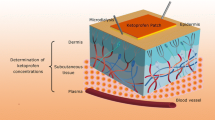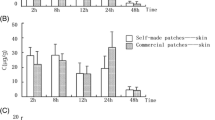Abstract
Purpose. The purpose of this study was to investigate the percutaneous absorption of ketoprofen applied topically to different anatomical sites on the body.
Methods. The study design was a randomized, four-way crossover in 24 healthy male subjects. One gram of ketoprofen 3% gel (30 mg dose) was applied every six hours for 25 doses over a 100 cm2 of the back, arm, and knee. A 0.5 ml of ketoprofen solution (60 mg/ml) was applied to the back as a reference treatment. Plasma and urine samples were obtained for the assay of racemic ketoprofen and ketoprofen enantiomers (S and R), respectively.
Results. The relative bioavailabilities of ketoprofen gel were 0.90 ± 0.50, 1.08 ± 0.63, and 0.74 ± 0.38 when applied to the back, arm, and knee, respectively. The plasma ketoprofen Cmax for gel applied to the back and arm were similar (p > 0.05) but Cmax was lower when applied to the knee (p < 0.05). The time to Cmax ranged from 2.7 to 4.0 hours and was similar for gel treatments on the back and arm, but longer for the knee treatment. The fraction of dose excreted in urine as total S and R enantiomers ranged from 5.41 to 9.10%.
Conclusions. The percutaneous absorption of ketoprofen was similar when applied to either the back or arm but was lower when applied to the knee.
Similar content being viewed by others
REFERENCES
T. Kantor. Ketoprofen: A review of its pharmacological and clinical properties. Pharmacotherapy. 6:93–103 (1986).
G. L. Flynn, E. E. Linn, T. Kurihara-Bergstrom, S. K. Govil, and S. E. Hou. Parameters of skin condition and function. In A. F. Kydonieus and B. Berner (eds.), Transdermal Delivery of Drugs (Volume II), CRC Press, Inc., Boca Raton, Florida, 1987, pp. 3–17.
J. E. Shaw, M. E. Prevo, and A. A. Amkraut. Testing of controlled-release transdermal dosage forms: Product development and clinical trials. Arch. Dermatol. 123:1548–1556 (1987).
R. J. Feldman and H. I. Maibach. Regional variation in percutaneous penetration of [14C] cortisol in man. J. Invest. Dermatol. 48:181–183 (1967).
A. Avgerinos and A. Hutt. Determination of the enantiomeric composition of ibuprofen in human plasma by high-performance liquid chromatography. J. Chromatogr. 415:75–83 (1987).
M. Gibaldi and D. Perrier. Pharmacokinetics (second edition), Marcel Dekker, New York, 1982.
SAS, Version 6.0, Cary, NC: SAS Institute Inc., 1990.
R. A. Upton, R. L. Williams, T. W. Guentert, J. N. Buskin, and S. Riegelman. Ketoprofen pharmacokinetics and bioavailability based on an improved sensitive and specific assay. Eur. J. Clin. Pharmacol. 20:127–133 (1981).
R. Ballerini, A. Casini, M. Chinol, C. Mannucci, L. Giaccai, and M. Salvi. Study on the absorption of ketoprofen topically administered in man: Comparison between tissue and plasma levels. Int. J. Clin. Pharm. Res. 6:69–72 (1986).
R. J. Scheuplein and I. H. Blank. Permeability of the skin. Physiol. Rev. 51:702–747 (1971).
D. Debruyne, B. H. deLigny, J. Ryckelynck, F. Albessard, and M. Moulin. Clinical pharmacokinetics of ketoprofen after single intravenous administration as a bolus or infusion. Clin. Pharmacokin. 12:214–221 (1987).
B. Flouvat, A. Roux, and B. Delhotal-Landes. Pharmacokinetics of ketoprofen in man after repeated percutaneous administration. Drug Res. 39:812–815 (1989).
R. A. Upton, J. N. Buskin, R. L. Williams, N. H. G. Holford, and S. Riegelman. Negligible excretion of unchanged ketoprofen, naproxen or probenecid in urine. J. Pharm. Sci. 69:1254–1257 (1980).
F. Jamali, A. S. Russell, R. T. Foster, and C. Lemko. Ketoprofen pharmacokinetics in humans: Evidence of enantiomeric inversion and lack of interaction. J. Pharm. Sci. 79:460–461 (1990).
T. Ishizaki, T. Sasaki, T. Suganima, Y. Horai, K. Chiba, M. Watanabe, W. Asuke, and H. Hoshi. Pharmacokinetics of ketoprofen following single oral, intramuscular and rectal doses and after repeated oral administration. Eur. J. Clin. Pharmacol. 18:407–414 (1980).
Author information
Authors and Affiliations
Rights and permissions
About this article
Cite this article
Shah, A.K., Wei, G., Lanman, R.C. et al. Percutaneous Absorption of Ketoprofen from Different Anatomical Sites in Man. Pharm Res 13, 168–172 (1996). https://doi.org/10.1023/A:1016014308638
Issue Date:
DOI: https://doi.org/10.1023/A:1016014308638




